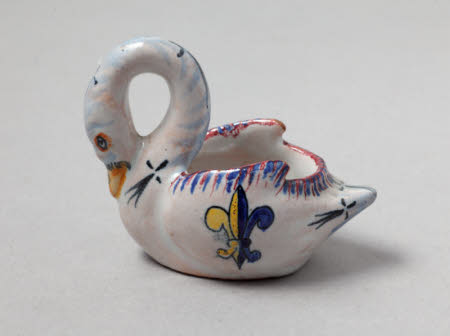Untitled
Category
Ceramics
Date
1890 - 1910
Materials
Tin-glazed earthenware
Measurements
50 mm (Height)
Place of origin
Quimper
Order this imageCollection
Hill Top, Cumbria
NT 641559
Summary
Salt in the form of a swan, faience (tin-glazed earthenware), terracotta body, the neck of the swan forming a loop, the wings raised to create an uneven rim, Quimper, France, ca 1890-1910; decorated with the figure of a woman knitting to one side, a fleur de lys on the opposing side in blue and yellow, red and blue dashes to the rim, orange details to the eye and beak.
Full description
This miniature swan is part of the collection at Hill Top. Beatrix Potter purchased this farmhouse in the Lake District village of Near Sawrey in 1905, using the profits from her books. After her marriage to William Heelis in 1913, Beatrix relocated permanently to Sawrey. The couple made nearby Castle Cottage their home, but Beatrix spent as much time as she could at Hill Top. As well as a space for work and creativity – and the location for many of her famous tales – it became an intensely personal sanctuary for her. Beatrix knew exactly how she would decorate Hill Top and she arranged its interiors carefully and deliberately. She wrote: ‘I would have old furniture…it is not as expensive as modern furniture, and incomparably handsomer…’ Once she had renovated the farmhouse, she filled it with examples of local furniture and treasured heirlooms, like her grandmother’s warming pan and a set of plates decorated with designs by her father. The 1914 inventory of Beatrix’s family home, Bolton Gardens, South Kensington, lists ‘Bretaigne ware and Amphora, decorated fleur-de-lys etc. in blue’ in the Drawing Room, which might refer to this object and other pieces of Quimper pottery now at Hill Top. The swan was probably made in Quimper, Brittany, where several potteries in the town produced tin-glazed earthenware decorated in a distinctive local style. They often depict men and women in traditional Breton dress and sometimes the fleur de lys, a symbol of France – both seen on this object. The cross-like marks on the tail and neck of the swan are from the Brittany coat of arms, where they symbolise ermine spots. Swans were a popular form for the Quimper potters and were used for jardinieres (plant pots), egg stands and small containers for serving salt, like this example. The object is recorded as having moved from Troutbeck Park, so might have been used to furnish Beatrix’s study at the property.
Provenance
From Troutbeck Park.
